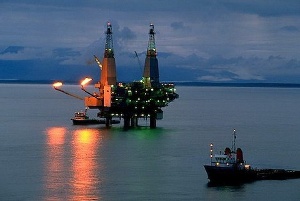The $7 billion OCTP Sankafa gas deal between the Government of Ghana and Italian oil firm ENI is bloated by at least $2 billion, out of which some Ghanaian government officials will cut their kickbacks, the Minority in parliament has alleged.
“As has been stated earlier by the communications directorate of the NPP, it does appear that the contract is bloated by between 2 and 3 billion US dollars to the disadvantage of Ghana,” the Minority said at a press conference in Parliament on Thursday February 11 addressed by William Owuraku Aidoo, MP for Afigya Kwabre South and member of the Mines and Energy Committee of the House.
The Minority wondered why the Government of Ghana would bend backwards to “sprinkle such quantum of roses in the way of ENI and Vitol.”
“In doling two billion dollars out, God knows how much somebody in government will be taking as kickback… The agreement stinks, it is a rip off and cannot be allowed,” the Minority said.
The OCTP Integrated Oil and Gas Project includes the combined development of the Sankofa Main, Sankofa East, Gye Nyame, Sankofa East Cenomanian and Sankofa East Campanian fields. The former three are non-associated gas fields while the latter two are oil fields. The development of the fields started in January 2015.
The fields are located within the OCTP block in the Tano Basin, at water depths ranging from 600m to 1,000m and approximately 60km off the coast of Ghana. The area covered by the fields is approximately 694km².
Eni's subsidiary Eni Ghana Exploration and Production is the operator of the block and holds a majority stake of 47.22% in the same. Vitol Upstream Ghana holds a 37.78% interest in the block and state-owned Ghana National Petroleum Corporation holds a 15% interest, with an option to further increase its share by an additional 5%.
The overall investment on the project is estimated to reach $7bn. The World Bank is providing a partial risk guarantee for the project.
OCTP reserves and production
The offshore fields are estimated to hold approximately 1.5 trillion cubic feet (tcf) of gas and approximately 500 million barrels of oil. The reserves are expected to continuously feed Ghana's thermal power plants for more than 20 years.
Oil production from the project is expected to start in 2017 and peak at 80,000 barrels of oil a day in 2019, whereas gas production is expected to start in 2018, with a daily production capacity of 170 million cubic feet. This would be enough to generate an additional 1,100MW of power for Ghana.
Ghana's OCTP development details
The development plan calls for the installation of subsea production systems, in addition to flowlines and risers connected to a leased floating, production, storage and offloading (FPSO) vessel.
The contract for the chartering, operation and maintenance of the FPSO was awarded to Yinson Holdings in January 2015. The charter period is for a term of 15 years with an option to extend it by five more years. The contract value is currently estimated at $2.54bn, but will increase to $3.25bn if Eni opts for the additional five-year chartering extension.
OCTP FPSO details
The OCTP FPSO will be converted from the Yinson Genesis tanker (formerly Ulriken) which, Yinson Holdings acquired from Golden State Petro in October 2014. It will have a storage capacity of 1.7 million barrels, oil processing capacity of 58,000 barrels a day, gas injection capacity of 150 million standard cubic feet a day (Mmscfd), and maximum future gas-export capacity of 210Mmscfd.
OCTP gas and oil export facilities
Gas from the fields will be processed in the FPSO and transported via a pipeline to onshore gas-receiving facilities located near the village of Sanzule in the western region of Ghana. The gas will further be compressed and injected into the Western Corridor Gas Pipeline and supplied to domestic industrial customers. Crude oil will be stored in the FPSO and will be supplied to international markets by means of tankers.
Ghana's Ministry of Energy has further agreed to enhance the gas transmission system with compression stations and connections to industrial users, to complement the OCTP project.
Discovery and drilling of the Offshore Cape Three Points fields
The Sankofa field was discovered in September 2009, with the drilling of the Sankofa-1 well in a water depth of 866m and to a total depth of 3,704m. It encountered high-quality reservoir sands containing 36m of net oil and gas.
The well is situated approximately 35km east of the Jubilee fields.
The field was further appraised in April 2011 by drilling the Sankofa-2 well at a water depth of 864m. It flowed 29.5Mmscfd of high-quality gas and 1,000boepd of 52° API condensate during test. It confirmed the presence of 35m net gas and condensate sands of the Cretaceous age.
The Gye Nyame field was discovered in July 2011 by drilling the Gye Nyame 1 well. The well was drilled to a total depth of 3,349m at a water depth of 519m and encountered significantly thick gas and condensate sands. The field is located 16km east of the Sankofa field.
The Sankofa East field was discovered by drilling the Sankofa East-1X well in September 2012. The well was drilled to a total depth of 3,650m in 825m of water, and encountered 28m of gas and condensate and 76m of gross oil pay in cretaceous sandstones. It produced about 5,000 barrels of high-quality oil a day during test.
The Sankofa East 2A well, the first appraisal well of the Sankofa East, was drilled in January 2013 to confirm the extension of the oil accumulation in the Cenomanian sequence. It was drilled to a total depth of 4,050m in water depth of 990m and encountered 23m of gas and 17m of net gas, as well as 32m of net oil in cretaceous sands.
General News of Thursday, 11 February 2016
Source: classfmonline.com

















